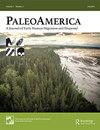镶嵌在石头上的克洛维斯生活方式:凹槽点形态变异的贡献
IF 1.7
Q1 ANTHROPOLOGY
引用次数: 0
摘要
摘要 在过去的一个世纪中,研究人员发现凹槽点的形状和大小在美洲呈现出不同的模式。其中许多模式可以通过地理、生态和行为变量来组织,并帮助我们形成了目前对西半球最早的一些文化的理解。本文回顾了研究人员在过去三十年中如何评估克洛维斯点形态变异的模式,并讨论了用于制定和检验有关克洛维斯人如何在地形上移动或传递文化信息,如何组织、制造和使用凹槽点技术,以及如何与后来的古印第安人群体建立联系的假设的数据类型。文章最后总结了对克洛维人凹槽点形态的研究对我们了解克洛维人的适应性所做的贡献,这些研究是包括遗传学、动物和植物遗骸、工具石特征、组合结构、遗址形成过程和古环境数据在内的大量证据的一部分。本文章由计算机程序翻译,如有差异,请以英文原文为准。
Clovis Lifeways Set in Stone: The Contribution of Fluted-Point Morphological Variation
ABSTRACT Over the past century, researchers have found variation in fluted-point shape and size to be patterned in the Americas. Many of these patterns can be organized by geographical, ecological, and behavioral variables, and have helped formulate our current understanding of some of the earliest cultures to live in the Western Hemisphere. This paper reviews how researchers have assessed patterns in Clovis point morphological variability over the last three decades and discusses types of data used to formulate and test hypotheses concerning how Clovis peoples moved or transmitted cultural information across the landscape, organized, manufactured, and used fluted-point technology, and related to later Paleoindian groups. It concludes by summarizing the contribution studies of Clovis-point form have made to our understanding of Clovis adaptation as part of a greater body evidence that includes genetics, faunal and botanical remains, toolstone characterization, assemblage structure, site formation processes, and paleoenvironmental data.
求助全文
通过发布文献求助,成功后即可免费获取论文全文。
去求助
来源期刊

PaleoAmerica
Earth and Planetary Sciences-Paleontology
CiteScore
3.70
自引率
0.00%
发文量
15
期刊介绍:
PaleoAmerica disseminates new research results and ideas about early human dispersal and migrations, with a particular focus on the Americas. It fosters an interdisciplinary dialog between archaeologists, geneticists and other scientists investigating the dispersal of modern humans during the late Pleistocene. The journal has three goals: First and foremost, the journal is a vehicle for the presentation of new research results. Second, it includes editorials on special topics written by leaders in the field. Third, the journal solicits essays covering current debates in the field, the state of research in relevant disciplines, and summaries of new research findings in a particular region, for example Beringia, the Eastern Seaboard or the Southern Cone of South America. Although the journal’s focus is the peopling of the Americas, editorials and research essays also highlight the investigation of early human colonization of empty lands in other areas of the world. As techniques are developing so rapidly, work in other regions can be very relevant to the Americas, so the journal will publish research relating to other regions which has relevance to research on the Americas.
 求助内容:
求助内容: 应助结果提醒方式:
应助结果提醒方式:


